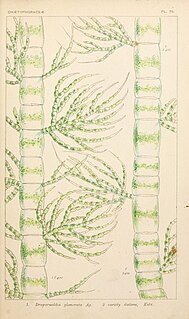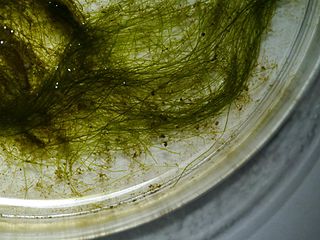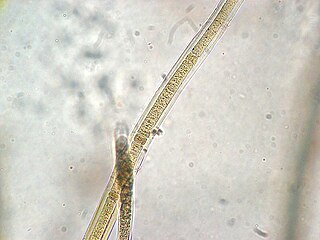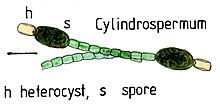
The glaucophytes, also known as glaucocystophytes or glaucocystids, are a small group of freshwater unicellular algae, less common today than they were during the Proterozoic. Only 15 species have been described, but more species are likely to exist. Together with the red algae (Rhodophyta) and the green algae plus land plants, they form the Archaeplastida. However, the relationships among the red algae, green algae and glaucophytes are unclear, in large part due to limited study of the glaucophytes.

Lyngbya is a genus of cyanobacteria, unicellular autotrophs that form the basis of the oceanic food chain.

Nostoc, also known as star jelly, troll’s butter, witch's butter, and witch’s jelly, is a genus of cyanobacteria found in various environments that forms colonies composed of filaments of moniliform cells in a gelatinous sheath.

Merismopedia is a genus of cyanobacteria found in fresh and salt water. It is ovoid or spherical in shape and arranged in rows and flats, forming rectangular colonies held together by a mucilaginous matrix. Species in this genus divide in only two directions, creating a characteristic grid-like pattern.

Draparnaldia is a genus of freshwater green algae in the family Chaetophoraceae. Draparnaldia are uniseriate; each filament is composed of a chain of cells arranged in one row. Chloroplasts appear as a band within the center of each cell. The length of the main axis cells are generally the same, regardless of whether or not they bear branches. These side branches are divided extensively into terminal hairs. The entire plant is enveloped in loose, slippery mucilage. Draparnaldia is a cosmopolitan genus with wide distribution and it is usually found in cold aerated waters. They are either attached to sand or grow epiphytically on other aquatic plants. Draparnaldia can be seen growing in clear streams trailing on stones and boulders. Herman S. Forest of The Southern Appalachian Botanical Club has stated that while not common, it is present frequently enough to be recorded in almost all local flora lists of green algae that have been compiled. A multitude of species are present in Lake Baikal, Siberia and have been described by Meyer and Jasnitzky. A species of the genus had been placed and described in the Linnean Herbarium as Conferva Mutabilis Roth in 1797. Nowadays Conferva is no longer used and the species is described as Draparnaldia mutabilis (Roth) Bory. Bory is added in honour of the researcher of the same name, based on whose description the genus was separated from similar appearing forms. Bory is accredited with the establishment of the genus.

Golenkinia is a genus of green algae first described in 1894 by Robert Chodat. The genus is named for the Russian phycologist Mikhail Iljitsch Golenkin. Golenkinia species live in fresh water and are found around the world.
Rhexinema is a genus of green algae in the order Ulotrichales. Recent research has suggested that the genus Helicodictyon is a synonym of Rhexinema.

The Rivulariaceae are a family of cyanobacteria within the Nostocales in which the filaments (trichomes) are tapered from wider at the base to narrower at the tip.
Cylindrospermopsis is a planktonic genus of filamentous cyanobacteria known for its blooms in eutrophic waters. The type species is the tropical Cylindrospermopsis raciborskii (Woloszynska) Seenayya & Subbaraju. The cyanotoxin cylindrospermopsin was first identified from a species of this genus.

Vaucheria is a genus of Xanthophyceae or yellow-green algae. It is one of only two genera in the family Vaucheriaceae. The type species of the genus is Vaucheria disperma.
Zygnema is a genus of freshwater filamentous thalloid alga comprising about 100 species. A terrestrial species, Z. terrestre, is known from India. Zygnema grows as a free-floating mass of filaments, although young plants may be found anchored to streambeds with a holdfast. The filaments form a yellow-green to bright green colored tangled mat, and are composed of elongate barrel-shaped cells, each with two star-shaped (stellate) chloroplasts arrayed along the axis of the cell.
Prochloron is a genus of unicellular oxygenic photosynthetic prokaryotes commonly found as an extracellular symbiont on coral reefs, particularly in didemnid ascidians. Part of the phylum cyanobacteria, it was theorized that Prochloron is a predecessor of the photosynthetic components, chloroplasts, found in photosynthetic eukaryotic cells. However this theory is largely refuted by phylogenetic studies which indicate Prochloron is not on the same line of descent that lead to chloroplast-containing algae and land plants.
Tribonema is a genus of filamentous, freshwater yellow-green algae. The holotype for the genus is the species Tribonema bombycina (C.Agardh) Derbès & Solier.
Anabaenopsis is a genus of filamentous, heterocystous cyanobacteria that reproduces by fragmentation and with akinetes. Anabaenopsis can produce microcystins, which are toxic to both humans and animals. The genus is primarily tropical and subtropical, with some species creating blooms in temperate regions during warmer seasons. Anabaenopsis contains bloom-formers among planktonic species.
Loefgrenia is a monospecific, freshwater, epiphytic genus of nonheterocystic cyanobacteria known from Brazil.
Wollea is a genus of filamentous, heterocystous cyanobacteria that form macroscopic colonies in freshwater habitats. The genus produces akinetes and is known to reproduce with hormogonia.

The Scytonemataceae are a family of filamentous, heterocystous cyanobacteria within the order Nostocales. The family is known from freshwater, marine, and terrestrial environments, where it grows in colonies attached to the substrate. Akinetes are not known, and the members of the family are known to reproduce with nonheterocystous hormogonia.

Petalonema is a genus of cyanobacteria. These species occur in freshwater habitats, on rocks, in soil, and as epiphytes.
Cyanonephron is a genus of cyanobacteria in the family Synechococcaceae.
Proaulopora is a Cambrian–Ordovician fossil genus of calcareous algae. It has been variously thought to belong to the green algae, red algae or cyanobacteria. It was originally established by the Russian paleontologist Aleksandr Grigoryevich Vologdin in 1937, for species known from the Lower Cambrian of the western Altai Mountains.











